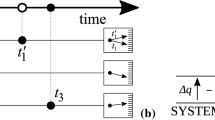Abstract
We study the conservation of energy, or lack thereof, when measurements are performed in quantum mechanics. The expectation value of the Hamiltonian of a system changes when wave functions collapse in accordance with the standard textbook (Copenhagen) treatment of quantum measurement, but one might imagine that the change in energy is compensated by the measuring apparatus or environment. We show that this is not true; the change in the energy of a state after measurement can be arbitrarily large, independent of the physical measurement process. In Everettian quantum theory, while the expectation value of the Hamiltonian is conserved for the wave function of the universe (including all the branches), it is not constant within individual worlds. It should therefore be possible to experimentally measure violations of conservation of energy, and we suggest an experimental protocol for doing so.


Similar content being viewed by others
Notes
The fact that energy is simply “distributed among different branches” depends on our assumption that the Hamiltonian included no off-diagonal matrix elements between different environment states. This is reasonable, but if it were not true, our result that observers can experience violations of energy conservation would be unaltered; we would merely lose the interpretation of the total energy as the sum of the energies of the branches, weighted by the amplitudes-squared.
It would be important to ensure that the spin states of particle 1 did not decohere when it was put into the magnetic field, in effect measuring the spin before the experiment started. If that were the case, the particle would simply be taking different amounts of energy from the magnetic field in two distinct branches of the wave function.
Decoherence and the linearity of the Schrödinger equation ensure that communication between different branches of the wave function is not possible. If it were, we might imagine systematically transferring energy from one branch to another—an “Everett pipeline,” analogous to Polchinski’s “Everett phone” [24]. This might be an argument in favor of the linearity of quantum mechanics, if one wanted to avoid perpetual motion machines. We thank Grant Remmen for this observation.
References
Wallace, D.: The quantum measurement problem: State of play. In: Rickles, D. (ed.) The Ashgate Companion to Contemporary Philosophy of Physics, Ashgate (2007)
Hartle, J.B., Laflamme, R., Marolf, D.: Conservation laws in the quantum mechanics of closed systems. Phys. Rev. D 51(12), 7007 (1995)
Griffiths, R.: Unpublished
Pearle, P.M.: Wave function collapse and conservation laws. Found. Phys. 30, 1145–1160 (2000). https://doi.org/10.1023/A:1003677103804
Pearle, P.M.: Combining stochastic dynamical state vector reduction with spontaneous localization. Phys. Rev. A 39, 2277–2289 (1989). https://doi.org/10.1103/PhysRevA.39.2277
Ghirardi, G.C., Pearle, P.M., Rimini, A.: Markov processes in hilbert space and continuous spontaneous localization of systems of identical particles. Phys. Rev. A 42, 78–79 (1990). https://doi.org/10.1103/PhysRevA.42.78
Ghirardi, G., Rimini, A., Weber, T.: A unified dynamics for micro and macro systems. Phys. Rev. D 34, 470 (1986). https://doi.org/10.1103/PhysRevD.34.470
Vinante, A., Bahrami, M., Bassi, A., Usenko, O., Wijts, G., Oosterkamp, T.: Upper bounds on spontaneous wave-function collapse models using millikelvin-cooled nanocantilevers. Phys. Rev. Lett. 116(9), 090402 (2016)
Aharonov, Y., Popescu, S., Rohrlich, D.: On conservation laws in quantum mechanics, arXiv e-printsarXiv: 1609.05041 [quant-ph] (2016)
Gao, S.: The Meaning of the Wave Function. Cambridge University Press, Cambridge (2018). https://doi.org/10.1017/9781316407479
Gisin, N., Zambrini Cruzeiro, E.: Quantum measurements, energy conservation and quantum clocks. Ann. Phys. 530(6), 1700388 (2018)
Maudlin, T., Okon, E., Sudarsky, D.: On the status of conservation laws in physics: implications for semiclassical gravity, arXiv: 1910.06473 [gr-qc]
Sołtan, S., Frączak, M., Belzig, W., Bednorz, A.: Is energy conserved when nobody looks?, arXiv e-printsarXiv: 1907.06354 [quant-ph] (2019)
Everett, H.: Relative state formulation of quantum mechanics. Rev. Mod. Phys. 29, 454–462 (1957). https://doi.org/10.1103/RevModPhys.29.454
Wallace, D.: The Emergent Multiverse: Quantum Theory According to the Everett Interpretation. Oxford University Press, Oxford (2012)
Duerr, D., Goldstein, S., Tumulka, R., Zanghi, N.: Bohmian mechanics, arXiv: 0903.2601 [quant-ph]
Leifer, M.S.: Is the quantum state real? an extended review of \(\psi \)-ontology theorems. Quanta 3(1), 67 (2014). arXiv: 1409.1570
Levitt, M.H.: Spin Dynamics: Basics of Nuclear Magnetic Resonance. Wiley, New York (2015)
Codata value: neutron gyromagnetic ratio. https://physics.nist.gov/cgi-bin/cuu/Value?gamman
Codata value: proton gyromagnetic ratio. https://physics.nist.gov/cgi-bin/cuu/Value?gammap
Halliwell, J., Thorwart, J.: Life in an energy eigenstate: decoherent histories analysis of a model timeless universe. Phys. Rev. D 65, 104009 (2002). https://doi.org/10.1103/PhysRevD.65.104009
Boddy, K.K., Carroll, S.M., Pollack, J.: De Sitter space without dynamical quantum fluctuations. Found. Phys. 46(6), 702–735 (2016). https://doi.org/10.1007/s10701-016-9996-8
Lloyd, S.: Decoherent histories approach to the cosmological measure problem, arXiv: 1608.05672 [quant-ph]
Polchinski, J.: Weinberg’s nonlinear quantum mechanics and the EPR paradox. Phys. Rev. Lett. 66, 397–400 (1991). https://doi.org/10.1103/PhysRevLett.66.397
Cao, C., Carroll, S.M., Michalakis, S.: Space from Hilbert space: recovering geometry from bulk entanglement. Phys. Rev. D95(2), 024031 (2017). https://doi.org/10.1103/PhysRevD.95.024031
Cao, C., Carroll, S.M.: Bulk entanglement gravity without a boundary: towards finding Einstein’s equation in Hilbert space. Phys. Rev. D 97(8), 086003 (2018). https://doi.org/10.1103/PhysRevD.97.086003
Cotler, J.S., Penington, G.R., Ranard, D.H.: Locality from the spectrum. Commun. Math. Phys. 368(3), 1267–1296 (2019). https://doi.org/10.1007/s00220-019-03376-w
Carroll, S.M., Singh, A.: Mad-dog everettianism: quantum mechanics at its most minimal. In: Aguirre, A., Foster, B., Merali, Z. (eds.) What is Fundamental?, pp. 95–104. Springer, New York (2019)
Carroll, S.M. : Reality as a vector in Hilbert space, arXiv: 2103.09780 [quant-ph]
Acknowledgements
We would like to thank Anthony Bartolotta, Brad Fillipone, Jason Pollack, Ken Olum, Jonathan Oppenheim, Gil Refael, Grant Remmen, Ashmeet Singh, and Mark Wise for helpful discussions during the course of this project. This research is funded in part by the Walter Burke Institute for Theoretical Physics at Caltech, by the U.S. Department of Energy, Office of Science, Office of High Energy Physics, under Award Number DE-SC0011632, and by the Foundational Questions Institute.
Author information
Authors and Affiliations
Corresponding author
Additional information
Publisher's Note
Springer Nature remains neutral with regard to jurisdictional claims in published maps and institutional affiliations.
Rights and permissions
About this article
Cite this article
Carroll, S.M., Lodman, J. Energy Non-conservation in Quantum Mechanics. Found Phys 51, 83 (2021). https://doi.org/10.1007/s10701-021-00490-5
Received:
Accepted:
Published:
DOI: https://doi.org/10.1007/s10701-021-00490-5




